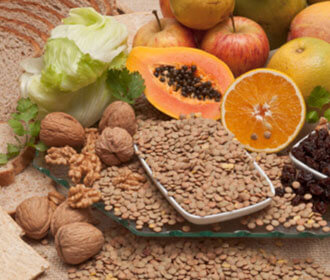The Truth About Fiber
 There's a lot of talk about sugar, salt and fat, but what about fiber? "People have gaps in their information about fiber," says Stephanie Fennessey, MS, RD, LD, CDE, clinical dietitian and diabetes educator at St. Luke's.
There's a lot of talk about sugar, salt and fat, but what about fiber? "People have gaps in their information about fiber," says Stephanie Fennessey, MS, RD, LD, CDE, clinical dietitian and diabetes educator at St. Luke's.
"For example, many people take fiber supplements but eat a very poor quality diet. Instead, we recommend a healthful diet that contains foods naturally high in fiber, so a fiber supplement is not needed." Fiber supplements can cause unpleasant side effects, such as flatulence. "Fiber supplements have not shown to have the same health benefits as whole foods that are naturally high in fiber – fruits, vegetables, whole grains, and legumes, for example," says Fennessey.
How much fiber do you need?
The daily recommended amount of fiber is 25 grams for women and 38 grams for men, according to the U.S. Dietary Guidelines. "The average in the U.S. is 15 grams of fiber per day, so most people are way below what is recommended," says Fennessey. "Another guideline is 14 grams of fiber per 1,000 calories. These recommendations are based on studies that were done for the prevention of heart disease." The amount of fiber is often misunderstood, according to Fennessey. "People think eating a salad with lots of lettuce is getting fiber, but in fact you're getting mostly water. If you add carrots, broccoli, cauliflower or a legume, then you'll be getting more fiber."
Lack of fiber affects your health
Some common diseases associated with lack of fiber include cardiovascular disease, type 2 diabetes and obesity. "Whole high-fiber foods, are often low in fat, sodium, and added sugars, which is beneficial in preventing these diseases," says Fennessey. Fiber not only helps prevent diseases, but also helps you maintain a healthy weight and healthy digestion. "A healthy diet that includes fruits, vegetables, whole grains, and legumes should meet your needs," she says. "But it's best to start out with small changes and increase your fiber gradually. If you raise it too quickly, you could have side effects such as cramping or constipation." Fruits and vegetables are the easiest for your body to process, so its an easy way to start increasing your fiber.
Foods with the highest amounts of fiber
- Blackberries, pears and apples
- Dried prunes, figs and apricots
- Peas, beans and lentils
- Grains such as bran and bulgar
- Whole wheat bread and pasta (look for bread with 3 to 5 grams of fiber per slice)
- Cereals such as shredded wheat, raisin bran or other bran cereals (look for 4 to 5 grams of fiber per serving)

